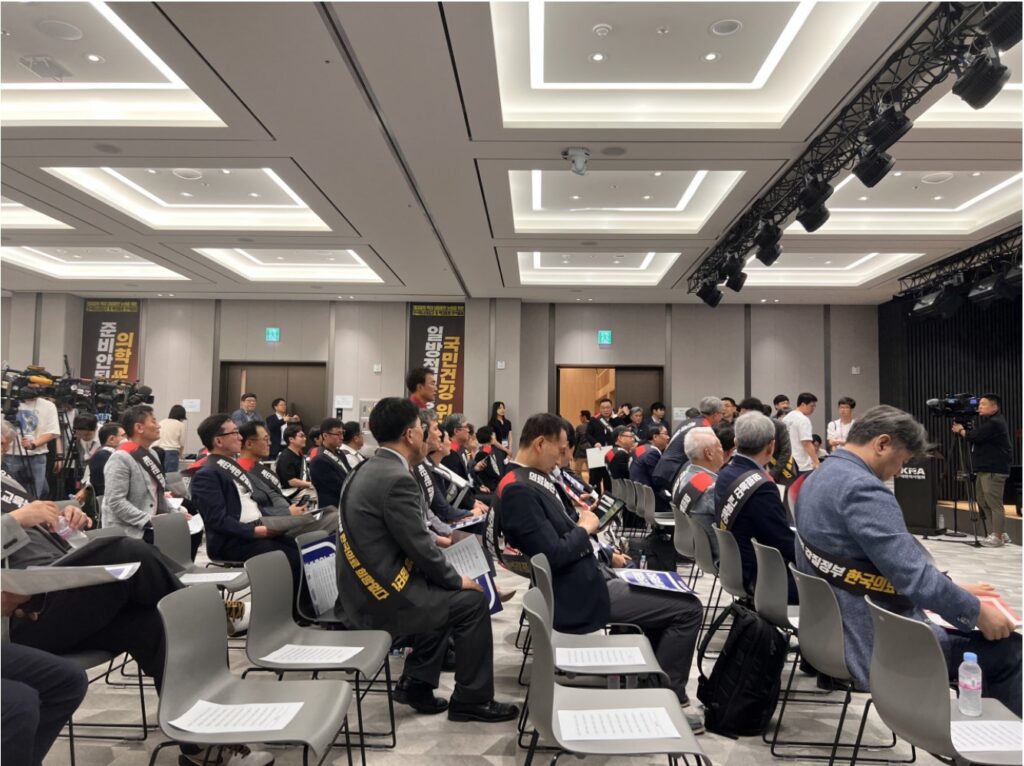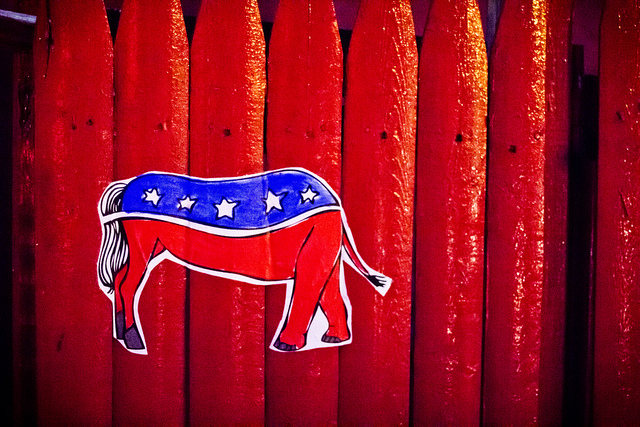On Feb. 20, thousands of trainee doctors in major South Korean hospitals staged a walkout to protest the government’s decision to increase the admission quota for medical students by 2,000. The government’s threats of legal action and public scrutiny have failed to dampen their spirits, as even senior doctors and medical professors have picked up their pitchforks to support the movement.
Five months after the initial walkout, there is still no end in sight. Strikes have continuously caused mass closure of hospitals, long waiting lines for patients and delayed medical treatment. With increased outrage from patient organizations, Health Ministry official Jun Byung-wang has even threatened to dissolve the country’s largest lobbying group for doctors, the Korean Medical Association.
The contentious government plan to increase the medical student quota has polarized the public and medical community. A poll carried out by the culture ministry showed 72.4 percent of Koreans supported the hike, while a survey conducted by the Research Institute of Healthcare Policy revealed that 81.7 percent of doctors oppose it.
The overwhelming public support has allowed government officials to openly criticize the movement, blaming the protesters for any patient deaths due to the lack of medical personnel. Some officials have even labeled their actions as “selfish” or “greedy.” An estimated 12,000 medical trainees have not returned to work after the initial walkout, causing delays in surgeries and disruptions in emergency rooms.

A medical school professor submits a resignation form at a hospital in Seoul, South Korea. Source: Reuters
In the face of strong opposition from both the government and the public, the medical community refuses to back down. The Korean Medical Association, the country’s largest lobbying group for doctors, held another rally last June, with over 40,000 members present according to their headcount.
As demonstrators face fierce backlash from all sides, along with the risk of legal prosecution, the question arises: What are they so fervently fighting against?
Lack of Doctors
South Korea’s yearly quota for new medical students has remained unchanged since it was capped at 3,058 students per year in 2006. This is not the first attempt at quota reform. In 2020, the Moon Jae-in administration faced a similar protest from doctors when the COVID-19 outbreak prompted a proposal to expand the quota by 4,000 students—400 per year, spread out over 10 years.
The new reform proposal by President Yoon Suk Yeol aims to increase medical school enrollments by 2,000 to 5,058 starting in 2025 for five years. The Ministry of Health and Welfare (MOHW) stated in a press release that they would “adjust the quota on a regular basis on estimated demands.”
The purpose of the policy is to tackle the growing demand for medical care as Korea’s population continues to age rapidly. It is also a response to the shortage of physicians. As of 2021, South Korea counted 2.6 doctors per 1,000 people, far below the Organisation for Economic Co-operation and Development recommended average of 3.7.
Currently, the country already has insufficient medical staff in essential fields such as pediatrics, emergency care, and high-risk surgeries. The MOHW projects a deficit of 15,000 doctors in 2035 if no measures are taken.
Mo doctors, mo problems?
The medical community views the quota expansion as a superficial treatment of the symptoms, not the disease. They believe that the organization of South Korea’s health insurance system is to blame for the lack of medical staff.
Hospitals can only charge fixed fees for most essential medical care according to the country’s fee-for-service system, leading doctors to pursue careers in less regulated and more profitable areas like cosmetic surgery and dermatology.

Doctors attend a meeting held at the Korean Medical Association’s headquarters building. Source: The Korea Herald
The salary of a physician varies greatly depending on their department, as well. Notably, the salaries of pediatricians, emergency doctors and general surgeons are some of the lowest-paying sectors—an average dermatologist earns more than double the annual income of a pediatrician.
Additionally, doctors tend to avoid high-risk sectors due to poor working conditions, long hours, and the absence of a safety net protecting them from criminal punishment in case of malpractice.
Instead of boosting the number of doctors, the opposition urges the government to find an alternative solution to the health-care shortage by redistributing existing medical staff to less popular departments. They also emphasize the need to allocate doctors not just to less popular departments, but also to rural areas to address South Korea’s ongoing struggle with regional disparities.
“Increasing medical school admissions is not a solution that could salvage regional health care. Providing one-time cash support or forcing doctors to work at such places alone cannot attract doctors to rural areas. Simply placing doctors in rural areas when kindergartens, convenience stores and schools are closing due to regional decline will not solve the problem of medical vulnerability in those areas,” trainee doctor Ryu Ok Hada said.
The Korea Medical Association’s Research Institute for Healthcare Policy stated that, as of 2020, 75.6 percent of South Korean doctors worked in big cities, while only 4.3 percent worked in rural areas. Doctors prefer to work in big city hospitals due to their prestige and higher quality.
According to MOHW documents, 24 out of 35 regional medical centers failed to meet the necessary quota for doctors in 2023. Some hospitals had to resort to hiring doctors past their retirement age to avoid closing down completely.
“Because they are older, it is sometimes even difficult for them to stand on duty and their medical activities are limited by their physical conditions, but we have no choice because it is difficult to find doctors,” one hospital official commented.
The stabbing of Democratic Party leader Lee Jae-myung in January of this year caused national outrage when he was transferred from Busan to a hospital in Seoul for urgent treatment, saying he could have received excellent care in Busan as well.
The sudden increase in students is also predicted to burden the quality of medical education. Protesters are concerned that medical schools are unprepared for the sudden influx of new students and will be unable to properly train future doctors. Since the quota expansion is limited to medical schools outside the capital city, trust in doctors from rural schools might deteriorate, only worsening the existing disparity.
“Not only is there a huge discrepancy with the 350 students that the association initially proposed to increase the enrollment capacity for the 2025 academic year, but it is also an impossible number to accommodate in a short period considering the educational conditions of 40 medical schools and graduate schools nationwide,” The Korean Association of Medical Colleges stated in an earlier statement in February.
Doctors have expressed concerns that the reform will transform Korea’s health-care system to resemble the US, where high medical bills can lead to financial ruin. They anticipate overall medical expenses to rise significantly, with increased doctor numbers leading to supplier-induced demand. Patients might experience shorter appointments and overtreatment as competition between physicians might intensify.
Medical professors at Korea University released a statement saying they would go on strike yet again in July, urging the government to refrain from pressuring medical students and trainee doctors to return, and instead engage in dialogue.
“The medical sector sought dialogue by offering solutions and compromises, but the government has flatly ignored all that and abused its administrative order. We couldn’t overlook the situation where the government is oppressing powerless students and showing no attempts to engage in talks with junior doctors,” the statement read.
 Amber is a Korean-Dutch multimedia journalist, born and raised in Amsterdam. Coming from a mixed background, she offers an unique perspective on South Korean contemporary society through both written and video reporting. After earning a BA in Korean Studies with a minor in Journalism and New Media from Leiden University, Amber interned as a video journalist at South Korea’s top English newspaper The Korea Herald, where she primarily filmed and edited content for the company’s YouTube playlist ‘Life in Korea.’ She is currently based in Seoul as a freelance reporter.
Amber is a Korean-Dutch multimedia journalist, born and raised in Amsterdam. Coming from a mixed background, she offers an unique perspective on South Korean contemporary society through both written and video reporting. After earning a BA in Korean Studies with a minor in Journalism and New Media from Leiden University, Amber interned as a video journalist at South Korea’s top English newspaper The Korea Herald, where she primarily filmed and edited content for the company’s YouTube playlist ‘Life in Korea.’ She is currently based in Seoul as a freelance reporter.
- “I Love My Body”: Hwasa and Female Empowerment in K-Pop and Korean Society - May 6, 2025
- English Fever in South Korea - February 24, 2025
- South Korea’s Medical School Expansion – Cure Worse than the Disease? - October 20, 2024






